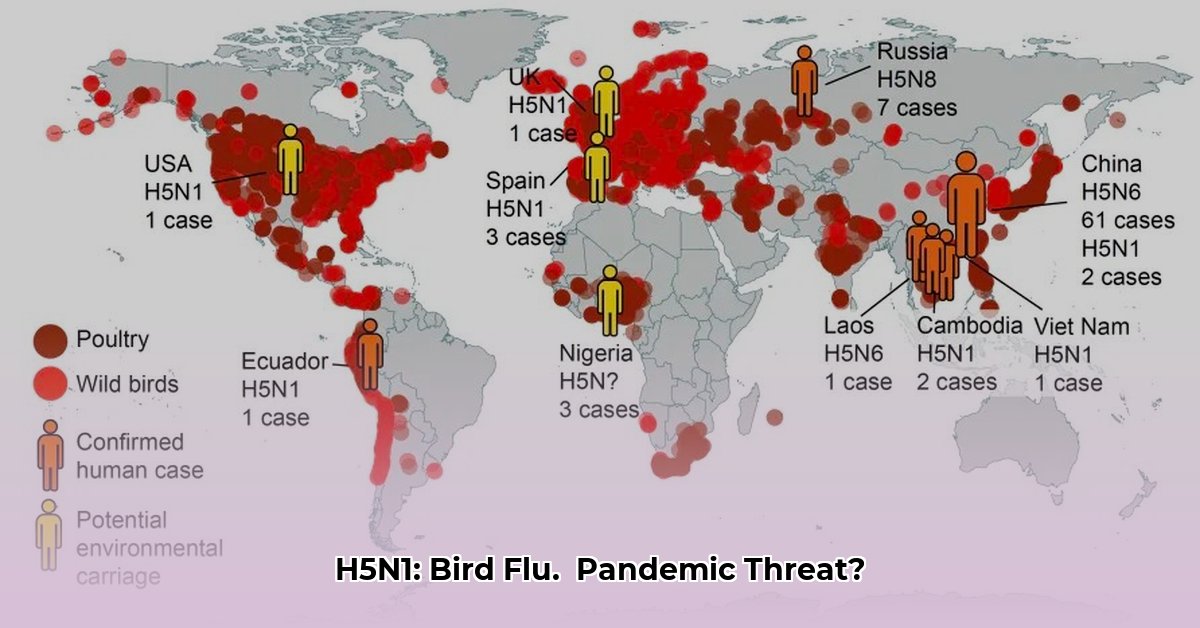Avian influenza, commonly known as bird flu, is circulating widely among bird populations worldwide. While the current risk to the general public remains low, the H5N1 strain’s potential to evolve into a human pandemic is a serious concern that demands close monitoring and proactive preparedness. This article provides a comprehensive overview of the current situation, the potential risks, ongoing research, and crucial preventative measures.
Understanding Bird Flu
What is Avian Influenza?
Avian influenza refers to a group of viruses that primarily infect birds. These viruses are classified into low and highly pathogenic avian influenza (LPAI and HPAI) based on their ability to cause disease. While LPAI viruses typically cause mild symptoms, HPAI viruses like H5N1 can lead to severe illness and high mortality rates in birds. Certain HPAI strains, including H5N1, have also demonstrated the ability to infect humans, albeit rarely.
The H5N1 Strain: A Cause for Concern
The H5N1 strain has raised particular concern due to its high pathogenicity in both birds and humans. While human infections are currently uncommon, occurring mainly through direct contact with infected birds, the virus’s capacity to mutate is worrisome. A mutation that facilitates efficient human-to-human transmission could trigger a pandemic.
The Current Situation
H5N1 is currently widespread among bird populations globally, with outbreaks reported across North America, Europe, and Asia. The virus continues to circulate in wild bird populations and has also impacted domestic poultry flocks, leading to culling in some areas to control the spread. Human cases, while still relatively rare, are being reported, serving as a stark reminder of the virus’s potential threat. The first reported H5N1 death in the U.S. in 2025 underscored the virus’s severity, even though the overall risk to the public remains low.
Pandemic Potential: Could H5N1 Trigger a Global Outbreak?
The possibility of H5N1 evolving into a pandemic virus is a real concern, though the likelihood remains uncertain. Several factors contribute to this uncertainty:
- Mutations: H5N1, like all influenza viruses, constantly mutates. While most mutations are inconsequential, some could enhance the virus’s ability to infect and spread among humans. Scientists are closely monitoring the virus for specific mutations of concern.
- Reassortment: Another possibility is reassortment, a process where H5N1 could mix with a human flu virus, potentially creating a hybrid virus with enhanced transmissibility and virulence in humans.
- Transmission Barriers: Currently, sustained human-to-human transmission of H5N1 is not occurring. Understanding the factors that prevent efficient spread among humans is crucial for assessing the pandemic risk.
Symptoms and Severity
In Birds:
H5N1 infection in birds can manifest in a variety of ways, ranging from mild symptoms like ruffled feathers and reduced egg production to severe illness and rapid death.
In Humans:
Human symptoms of H5N1 can range from mild, resembling a typical flu, to severe respiratory illness. Symptoms may include:
- Fever
- Cough
- Sore throat
- Muscle aches
- Conjunctivitis (eye irritation)
- Shortness of breath
- Pneumonia
- Acute Respiratory Distress Syndrome (ARDS)
Prompt medical attention is crucial if you suspect H5N1 infection.
Prevention and Preparedness
Individual Actions:
- Hand Hygiene: Frequent and thorough handwashing with soap and water or an alcohol-based sanitizer is essential.
- Avoid Contact: Steer clear of sick or dead birds, including poultry. If contact is unavoidable, use appropriate protective gear.
- Safe Food Handling: Ensure poultry and eggs are cooked thoroughly to an internal temperature of 165°F (74°C) to kill the virus.
Community and Global Efforts:
- Surveillance: Ongoing monitoring of bird populations for H5N1 is critical for early detection of outbreaks.
- Biosecurity: Implementing biosecurity measures on poultry farms helps prevent the spread of the virus between wild and domestic birds.
- Vaccine Development: Scientists are actively working on developing vaccines against H5N1. Several promising candidates are in development and clinical trials.
- Antiviral Treatments: Antiviral medications, such as oseltamivir (Tamiflu), can be used to treat H5N1 infection in humans.
Staying Informed: Your Best Defense
The bird flu situation is dynamic and rapidly evolving. Staying informed through reliable sources is crucial. Refer to the CDC and WHO for the latest updates, guidance, and public health advisories.
Ongoing Research and Uncertainties
While much is known about H5N1, significant uncertainties remain. Ongoing research is exploring:
- The likelihood of H5N1 mutating into a readily transmissible human virus.
- The potential severity of a future pandemic.
- The effectiveness of vaccines and antiviral treatments in a pandemic scenario.
- The impact of climate change on bird migration patterns and H5N1 spread.
By acknowledging these uncertainties and continuing to invest in research and preparedness, we can better protect global health from the potential threat of an H5N1 pandemic.







